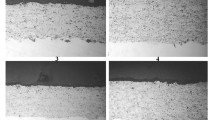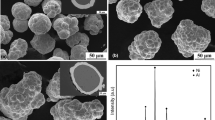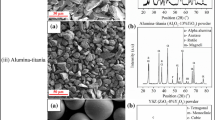The effect of plasma spraying parameters on the adhesion and porosity of metal ceramic coatings from clad (Ti, Cr)C–Ni composite powders was studied. The coatings were produced by atmospheric plasma spraying (APS) using a mixture of argon and hydrogen as plasma gases. The arc voltage and current were chosen as variable parameters for controlling the spraying distance and argon flow rate. The 40–80 μm (Ti, Cr)C-based composite powders clad with 17, 25, and 33 wt.% Ni were used to produce the plasma coatings. The microstructure, porosity, and adhesion of the coatings were studied to assess their quality. Optimal plasma spraying modes were determined for each powder. Plasma spraying should be conducted at an electric arc power of 27–29 kW. An increase in the power caused the nickel layer on the (Ti, Cr)C particles to evaporate and degrade, resulting in reduced coating uniformity, increased porosity, and decreased adhesion. The density and adhesive strength of the coatings improved as nickel content of the (Ti, Cr)C–Ni composite power increased from 17 to 33 wt.%. It was found that 17 wt.% Ni in the (Ti, Cr)C–Ni composite powders was not sufficient for producing high-quality plasma coatings. The (Ti, Cr)C–33 wt.% Ni coating had the highest adhesion (38 ± 1.5 MPa) and lowest porosity (7–8%).




Similar content being viewed by others
References
Yu.A. Kharlamov and L.G. Polonskii, “Thermal spraying. Current state and development prospects,” Visn. Skhidnoukr. Nats. Univ. Dala, No. 2, 5–9 (2016).
K.A. Yushchenko, Y.S. Borisov, V.D. Kuznetsov, V.M. Korzh, Surface Engineering [in Russian], Naukova Dumka, Kyiv (2007), p. 558 ISBN 978-966-00-0655-3.
Yu.S. Borisov, Yu.A. Kharlamov, S.A. Sidorenko, and E.N. Arbatovskaya, Powder Material Thermally Sprayed Coatings [in Russian], Naukova Dumka, Kyiv (1983), p. 568.
Jianhui Yuan, Yingchun Zhu, Xuebing Zheng, Heng Ji, and Tao Yang, “Fabrication and evaluation of atmospheric plasma spraying WC–Co–Cu–MoS2 composite coatings,” J. Alloys Compd., 509, Issue 5, 2576−2581 (2011), DOI: https://doi.org/10.1016/j.jallcom.2010.11.093.
Xiao-Qin Zhao, Hui-Di Zhou, and Jian-Min Chen, “Comparative study of the friction and wear behavior of plasma sprayed conventional and nanostructured WC–12% Co coatings on stainless steel,” Mater. Sci. Eng., 431, Issue 1–2, 290−297 (2006), https://doi.org/10.1016/j.msea.2006.06.009.
M. Heydarzadeh Sohi and F. Ghadami, “Comparative tribological study of air plasma sprayed WC–12% Co coating versus conventional hard chromium electrodeposit,” Tribology Int., 43, Issue 5–6, 882−886 (2010), DOI: https://doi.org/10.1016/j.triboint.2009.12.049.
Rabah Azzoug, Yamina Mebdoua, Fatah Hellal, and Francesco Marra, “Analysis of microstructure, mechanical indentation and corrosive behavior of a thermally sprayed NiFeCrBSi–WC composite coating,” J. Alloys Compd., 900, 163505 (2022), DOI: https://doi.org/10.1088/2053-1591/aba396.
Hongjian Guo, Bo Li, Cheng Lu, Qi Zhou, and Junhong Jia, “Effect of WC–Co content on the microstructure and properties of NiCrBSi composite coatings fabricated by supersonic plasma spraying,” J. Alloys Compd., 789, 966–975 (2019), https://doi.org/10.1016/j.jallcom.2019.02.290.
M.S. Storozhenko, A.P. Umanskii, A.E. Terentiev, and I.M. Zakiev, “Effect of the structure of TiB2–(Fe–Mo) plasma coatings on mechanical and tribotechnical properties,” Powder Metall. Met. Ceram., 56, No. 1–2, 60–69 (2017).
G. Bolelli, A. Colella, L. Lusvarghi, S. Morelli, P. Puddu, E. Righetti, P. Sassatelli, and V. Testa, “TiC–NiCr thermal spray coatings as an alternative to WC–CoCr and Cr3C2–NiCr,” Wear, 450–451, 203273 (2020), DOI: https://doi.org/10.1016/j.wear.2020.203273.
M. Rezapoor, M. Razavi, M. Zakeri, M.R. Rahimipour, and L. Nikzad, “Fabrication of functionally graded Fe–TiC wear resistant coating on CK45 steel substrate by plasma spray and evaluation of mechanical properties,” Ceram. Int. 44, Issue 18, 22378–22386 (2018), doi: https://doi.org/10.1016/j.ceramint.2018.09.001.
A.P. Umanskyi, A.Y. Terentiev, M.S. Storozhenko, G.A. Baglyuk, V.B. Muratov, O.O. Vasiliev, and V.Y. Sheludko, “Wetting and interfacial interaction in TiCrC–Ni system,” Function. Mater., 28, No. 3, 475–480 (2021), doi:https://doi.org/10.15407/FM28.03.475.
I.N. Gorbatov, V.M. Shkiro, A.E. Terentiev, L.K. Shvedova, I.S. Martsenyuk, S.I. Karpenko, “Studying the properties of thermal spray coatings from nickel–titanium and chromium carbide powders,” Fiz. Khim. Obrab. Mater., No. 4, 102–106 (1991).
I.N. Gorbatov, A.D. Panasyuk, and L.K. Shvedova, “Thermal spray coatings from titanium–chromium carbide composite powders,” Prot. Coat. Met., Issue 25, 22–25 (1991).
V.B. Raitses, V.M. Litvin, V.P. Rutberg, Z.S. Nagorska, and V.P. Brazhevskyi, “Wear-resistant plasma coatings based on a double carbide of titanium and chromium,” Powder Metall. Met. Ceram., 25, No. 10, 827–828 (1986).
Yu.S. Borisov, A.L. Borisova, M.V. Kolomytsev, O.P. Masyuchok, I.I. Timofeeva, and M.A. Vasilkovskaya, “High-velocity air plasma spraying of (Ti, Cr)C–32 wt.% Ni clad powder,” Powder Metall. Met. Ceram., 56, No. 5–6, 305–316 (2017).
M.S. Storozhenko, O.P. Umanskyi, G.A. Baglyuk, Yu.I. Evdokimenko, V.P. Brazhevskyi, O.O. Chernyshov, O.A. Bondarenko, I.S. Martsenyuk, V.B. Tarelnyk, O.Ye. Terentiev, and O.V. Melnyk, “Clad TiCrC(Ni) composite powders for thermal spraying of coatings,” Powder Metall. Met. Ceram., 60, No. 1–2, 1–6 (2021).
A.F. Ilyushchenko, A.I. Shevtsov, V.A. Okovitiy, and G.V. Gromyko, Processes of Gas-Thermal Coating Formation and Their Modeling, Monograph, Belaruska Navuka, Minsk (2011), p. 357 ISBN: 978-985-08-1270-4.
E.V. Panchenko, Yu.A. Skakov, B.I. Creamer, P.P. Arsentyev, K.V. Popov, M.Ya. Zwiling, Metal Laboratory, Ed. by B.G. Livshits, 2nd ed., revised and supplemented, Metallurgy, Moscow (1965), p. 440.
Acknowledgments
The publication contains the results of research conducted with the support of the Ministry of Education and Science of Ukraine (scientific and technical work under the state order for scientific and technical (experimental) developments and scientific and technical products, contract No. DZ/114-2021 of October 11, 2021).
Author information
Authors and Affiliations
Corresponding author
Additional information
Translated from Poroshkova Metallurgiya, Vol. 61, Nos. 9–10 (547), pp. 135–145, 2022.
Rights and permissions
Springer Nature or its licensor (e.g. a society or other partner) holds exclusive rights to this article under a publishing agreement with the author(s) or other rightsholder(s); author self-archiving of the accepted manuscript version of this article is solely governed by the terms of such publishing agreement and applicable law.
About this article
Cite this article
Umanskyi, O.P., Terentiev, O.Y., Storozhenko, M.S. et al. Effect of Plasma Spraying Parameters on the Properties of (Ti, Cr)C–Ni Composite Coatings. Powder Metall Met Ceram 61, 597–604 (2023). https://doi.org/10.1007/s11106-023-00348-7
Received:
Published:
Issue Date:
DOI: https://doi.org/10.1007/s11106-023-00348-7




